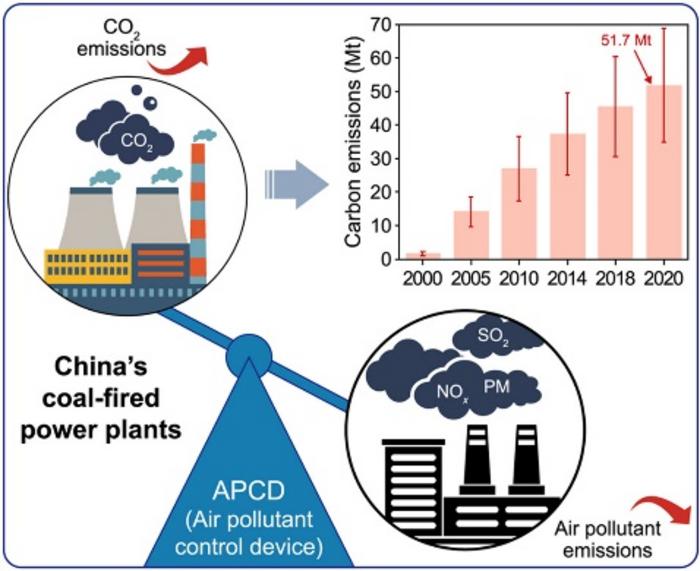To combat this issue, China has implemented various environmental regulations, including the widespread use of air pollution control devices (APCDs) in CFPPs. While APCDs have successfully reduced air pollutants, their electricity consumption has led to indirect carbon dioxide (CO2) emissions. The extent of these CO2 emissions has remained uncertain, prompting researchers to delve deeper into this overlooked environmental concern.

Credit: Environmental Science and Ecotechnology
To combat this issue, China has implemented various environmental regulations, including the widespread use of air pollution control devices (APCDs) in CFPPs. While APCDs have successfully reduced air pollutants, their electricity consumption has led to indirect carbon dioxide (CO2) emissions. The extent of these CO2 emissions has remained uncertain, prompting researchers to delve deeper into this overlooked environmental concern.
In a new study published in Volume 17 of the journal Environmental Science and Ecotechnology, researchers from Shandong University conducted a study revealing that the proportion of APCD CO2 emissions in total emissions from CFPPs surged from 0.12% in 2000 to 1.19% in 2020. Notably, desulfurization devices were the primary contributors, accounting for approximately 80% of APCD CO2 emissions in 2020, followed by dust removal and denitration devices. The researchers also projected future APCD CO2 emissions under different scenarios, highlighting the significant impact of CFPPs’ lifespan on emissions. They identified Nei Mongol, Shanxi, and Shandong provinces as potential hotspots for high emissions due to large-scale newly built CFPPs. To tackle this emerging environmental issue, the researchers proposed various measures, including enhancing APCD energy efficiency and providing low-carbon electricity through photovoltaic power or biomass co-firing with coal. They emphasized the need for comprehensive environmental impact assessments to ensure that policies aimed at reducing air pollutants do not inadvertently increase CO2 emissions. Furthermore, the study’s analysis framework offers valuable insights for other emission-intensive sectors, such as steel production and waste incineration.
Highlights
- CO2 emissions induced by air pollution control devices are quantified.
- A plant-level CO2 emission inventory is compiled.
- Future emissions under diverse climate targets are simulated.
- Hotspots of future emissions are identified.
The study’s findings have emphasized the importance of adopting integrated strategies to balance the reduction of both air pollutants and carbon emissions. The findings are expected to inform policymakers, industry stakeholders, and environmentalists alike, paving the way for more informed and holistic approaches to addressing China’s environmental challenges.
###
References
Funding information
The National Key Research and Development Program of China (2022YFC3105304),
The National Natural Science Foundation of China (72348001),
The National Social Science Fund of China (22&ZD108).
DOI
10.1016/j.ese.2023.100295
About Environmental Science and Ecotechnology
Environmental Science and Ecotechnology (ISSN 2666-4984) is an international, peer-reviewed, and open-access journal published by Elsevier. The journal publishes significant views and research across the full spectrum of ecology and environmental sciences, such as climate change, sustainability, biodiversity conservation, environment & health, green catalysis/processing for pollution control, and AI-driven environmental engineering. The latest impact factor of ESE is 12.6, according to the Journal Citation ReportTM 2022.
Journal
Environmental Science and Ecotechnology
DOI
10.1016/j.ese.2023.100295
Method of Research
Experimental study
Subject of Research
Not applicable
Article Title
Overlooked CO2 emissions induced by air pollution control devices in coal-fired power plants
Article Publication Date
25-Jul-2023
COI Statement
The authors declare that they have no competing interests




